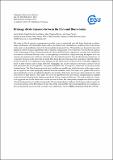Por favor, use este identificador para citar o enlazar a este item:
http://hdl.handle.net/10261/200348COMPARTIR / EXPORTAR:
 SHARE
BASE SHARE
BASE
|
|
| Visualizar otros formatos: MARC | Dublin Core | RDF | ORE | MODS | METS | DIDL | DATACITE | |

| Campo DC | Valor | Lengua/Idioma |
|---|---|---|
| dc.contributor.author | Struth, Lucía | - |
| dc.contributor.author | García-Castellanos, Daniel | - |
| dc.contributor.author | Viaplana-Muzas, M. | - |
| dc.contributor.author | Vergés, Jaume | - |
| dc.date.accessioned | 2020-02-12T08:17:12Z | - |
| dc.date.available | 2020-02-12T08:17:12Z | - |
| dc.date.issued | 2018-04-08 | - |
| dc.identifier | issn: 1029-7006 | - |
| dc.identifier.citation | Geophysical Research Abstracts, 20: EGU2018-8391 (2018) | - |
| dc.identifier.uri | http://hdl.handle.net/10261/200348 | - |
| dc.description.abstract | The study of fluvial network rearrangement provides a key to understand past and future landscape evolution. Large perturbations of hydrographic basins such as the change from endorheism to exorheism, have repercussion in the steady or disequilibrium state of the basins and their drainage divides. Water divides are dynamic features that migrate in order to reach an equilibrium with a complete reorganization of river networks. Previous fluvial analyses in the northern part of Iberia demonstrated that the Duero and Ebro basins experienced a change from endorheism to exorheism in Miocene-Pliocene times. A basin opening is recorded by a major retreating knickpoint wave that separates the upstream low-relief area (inherited from the endorheic period) from the downstream incised area, as is currently observed in the Duero but not in the Ebro basin. Recent works argue for a migration of the Ebro-Duero divide towards the west implying an area decrease for the Duero basin (victim) in favor of the Ebro (aggressor) based on field evidence and chi maps. However, topographic and chi-plot analyses at the basin scale have not yet been performed. We use river profiles, knickpoint distribution and chi analysis to understand the maturity of both drainage basins. The Ebro drainage network shows profiles near equilibrium with knickpoints in the upper reaches and no signal of low-relief topography inherited from the endorheic times. The Duero river profiles still record a major knickpoint (convex-up inflexion) related to the opening of the basin, preserving a large upstream low relief area (meseta or high-plateau). This argues for an out of equilibrium basin that remains reorganizing and adapting to the base level lowering by the opening towards the Atlantic during the Miocene. Chi analysis indicates a large-scale aggressor role for the Duero and a victim role for the Ebro. We consequently interpret two different signals of basin development at two different timescales. The geomorphological evidence and drainage analysis argues for a westward advance of the Ebro-Duero divide while in the long term the Duero major knickpoint wave migrates to the east incising the meseta in order to reach a new equilibrium. This is a MITE contribution (CGL2014-59516). | - |
| dc.description.sponsorship | This is a MITE contribution (CGL2014-59516). | - |
| dc.language | eng | - |
| dc.publisher | European Geosciences Union | - |
| dc.relation | info:eu-repo/grantAgreement/MINECO/Plan Estatal de Investigación Científica y Técnica y de Innovación 2013-2016/CGL2014-59516 | - |
| dc.relation.isversionof | Publisher's version | - |
| dc.rights | openAccess | en_EN |
| dc.title | Drainage divide dynamics between the Ebro and Duero basins | - |
| dc.type | comunicación de congreso | - |
| dc.date.updated | 2020-02-12T08:17:13Z | - |
| dc.rights.license | https://creativecommons.org/licenses/by/4.0/ | - |
| dc.contributor.funder | Ministerio de Economía y Competitividad (España) | - |
| dc.relation.csic | Sí | - |
| dc.identifier.funder | http://dx.doi.org/10.13039/501100003329 | es_ES |
| dc.type.coar | http://purl.org/coar/resource_type/c_5794 | es_ES |
| item.cerifentitytype | Publications | - |
| item.openairecristype | http://purl.org/coar/resource_type/c_18cf | - |
| item.grantfulltext | open | - |
| item.openairetype | comunicación de congreso | - |
| item.fulltext | With Fulltext | - |
| Aparece en las colecciones: | (Geo3Bcn) Comunicaciones congresos | |
Ficheros en este ítem:
| Fichero | Descripción | Tamaño | Formato | |
|---|---|---|---|---|
| EGU2018-8391.pdf | 33,26 kB | Adobe PDF |  Visualizar/Abrir |
CORE Recommender
Page view(s)
169
checked on 23-abr-2024
Download(s)
43
checked on 23-abr-2024
Google ScholarTM
Check
Este item está licenciado bajo una Licencia Creative Commons

